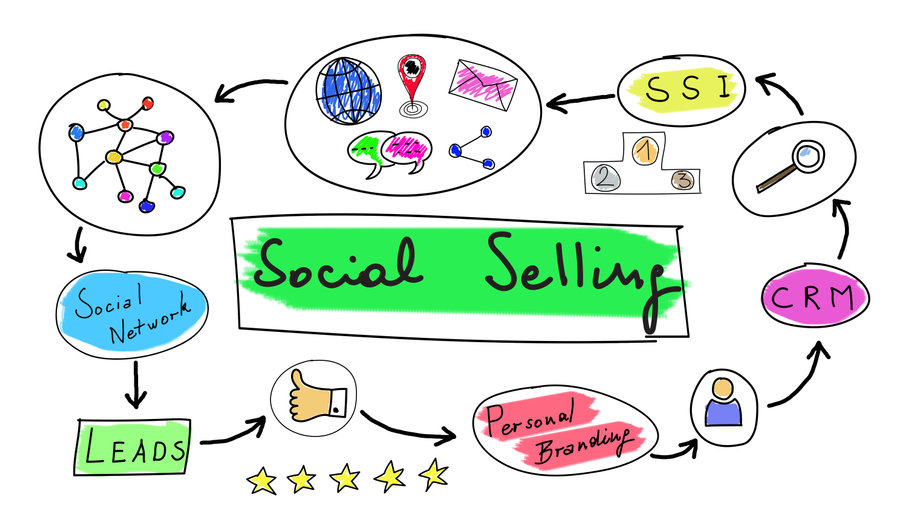
Social media continues to be a leading source of information, connection and promotion for B2B and B2C companies. These platforms create one of the most accessible routes to link companies with their target markets. Using social media does not necessarily mean a company has social selling acumen or a strategy for social selling. Social selling is the process of using social media to connect and engage with existing and prospective customers. While research shows that 98 percent of B2B enterprises see value in social selling, only 49 percent developed social selling programs. For social selling to be successful, it needs to be fueled by individuals of a brand, including marketers, salespeople, business development specialists or thought leaders who actively work to convert viable prospects into satisfied customers.
According to LinkedIn Sales Solutions, 78 percent of businesses that use social selling outsell businesses that don’t use social media. Whether you’re active on LinkedIn, Facebook, Twitter, Instagram, or other popular social media platforms, or are just getting started, boost your social selling acumen by considering the answers to these six questions.
Increasing Social Selling Acumen

- Why does social selling work? Jasper Willems of SalesSource states, “Think of the regular sales process as being interruptive. You cold-call people who might not want to speak to you and ask for a meeting they might or might not be interested in. Sometimes, these people merely tolerate this intrusion and at other times, they slam their doors in your face. The reason is simple; they feel they don’t know you and you haven’t earned the kind of audience you want.” On the other hand, social selling takes a different approach to generating and nurturing leads. By sharing the right content with the right audiences at the right time, social selling taps into your audience’s needs and wants and initiates conversations about relevant industry issues and the solutions you provide. According to Willems, “Social selling isn’t spamming people with unsolicited messages on social media. It’s engaging, educating and helping them with relevant views, then asking for something in return (later).”
- Why is it important to keep your profile up to date, succinct and brand aligned? Regardless of the social platforms you use, your personal and company profiles are central to a social selling strategy. If that information isn’t current, it creates mistrust and results in a lack of credibility. Additionally, it needs to be relevant to your audiences. Ask yourself what topics your target buyers care about and keep information concise and results-driven. Focus on benefits, not features. Ensure messaging, visuals and style stay true to your company’s brand.
- How does understanding your target markets’ preferences and needs help with social selling? Companies that conduct research to identify the platforms their audiences frequent and to seek information about their interests, pain points, challenges and habits create a selling and competitive advantage. Armed with this information, you can better position your company as a valuable solution provider.
- How can companies build relationships of mutual value and support? Rather than simply approaching every prospect with the intent to sell, seek to build a relationship. Be genuine and start a conversation that results in a dialogue. Social selling seeks to create interactions of value whether that activity or outcome results in a sale, a referral, a new connection or shared content. Engage directly with your audiences and target markets through personalized messaging, based on known challenges, previous interactions and shared connections.
- Why is it important to create and share customer-centric content via social selling? When content provides valuable insights, tips, problem-solution scenarios and other relevant information, it is more likely to capture the heart and minds of prospects and customers. Not only does this type of content educate, inform and engage audiences, it also creates a positive image of the seller and showcases their expertise. Content can take a variety of forms, so consider the medium that resonates with your target markets. Blog posts, industry news, marketplace research, polls, webinars and video operate well on social media.
- Why is it important to share and engage with the content of other connections and thought leaders? Social media and social selling thrive from shared content. It is important to reach out to anyone who likes, comments or shares your content to foster a new connection. It is also important to engage, comment and share the thought leadership of others. This step helps build rapport both with industry peers and target audiences. Start with clients, close connections and other relevant networks. From there, participate in relevant groups, webinars, conferences and other digital events to engage and discover content worth sharing and individuals to connect with.
It’s All About Relationships

Selling via social media might be a relatively new strategy, but its essence comes down to a known fact: success in sales and marketing is based on relationships. Social selling, despite its digital location, is no different. Just sending the connection or follow request isn’t enough. Target prospects carefully and focus on sharing valuable information to earn trust. From there, you can nurture leads based on sincere interest and curiosity. In the end, ask yourself, do you have an effective social selling strategy, or are you simply using social media?
